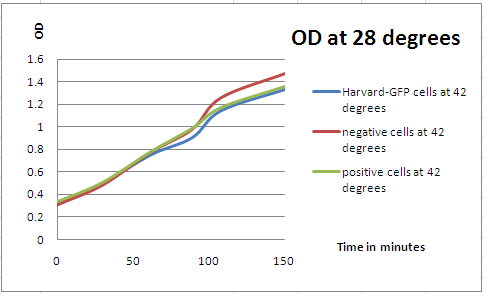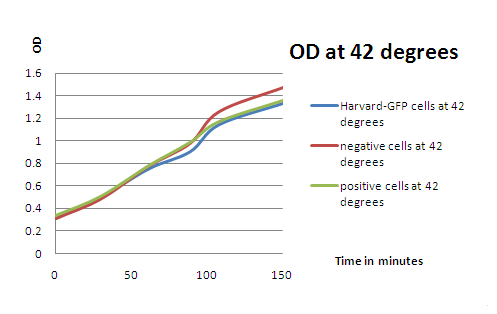Team:Imperial College London/Wetlab/Results/Thermoinduction
From 2009.igem.org
(→Growth rate for different blank medium levels) |
(→Experiment Rationale) |
||
| Line 2: | Line 2: | ||
<br><br> | <br><br> | ||
=Experiment Rationale= | =Experiment Rationale= | ||
| - | To investigate the behaviour of the lamda-cI thermoinducible | + | To investigate the behaviour of the lamda-cI thermoinducible promoter and show that when temperature is low (at 28 degrees Celsius), there is low fluorescence output. This shows that the genome deletion module is repressed. |
When temperature is raised to 42 degrees Celsius, fluorescence increases, indicating that the repression is lifted. | When temperature is raised to 42 degrees Celsius, fluorescence increases, indicating that the repression is lifted. | ||
| - | We are looking at both absorbance and fluorescence data. | + | We are looking at both absorbance and fluorescence data. This analysis serves to characterize the construct [http://partsregistry.org/wiki/index.php/Part:BBa_K200022 BBa_K200022], submitted by Harvard last year. |
| + | ==Summary of method== | ||
| + | In order to characterize the thermoinducible promoter, absorbance (optical density) and fluoresence data were recorded over time for: | ||
| + | * Cells containing the BBa_K200022 construct: The thermoinducible promoter. | ||
| + | * Positive control cells: Containing the [http://partsregistry.org/Part:BBa_I13522 BBa_I13522], acting as a baseline comparison by constitutively expressing GFP. | ||
| + | * Negative control cells: These contain the thermoinducible promoter on its own ( [http://partsregistry.org/Part:BBa_K098995 BBa_K098995]) with no GFP attached to it. | ||
=Absorbance data= | =Absorbance data= | ||
Revision as of 18:14, 21 October 2009

Contents |
Experiment Rationale
To investigate the behaviour of the lamda-cI thermoinducible promoter and show that when temperature is low (at 28 degrees Celsius), there is low fluorescence output. This shows that the genome deletion module is repressed. When temperature is raised to 42 degrees Celsius, fluorescence increases, indicating that the repression is lifted. We are looking at both absorbance and fluorescence data. This analysis serves to characterize the construct [http://partsregistry.org/wiki/index.php/Part:BBa_K200022 BBa_K200022], submitted by Harvard last year.
Summary of method
In order to characterize the thermoinducible promoter, absorbance (optical density) and fluoresence data were recorded over time for:
- Cells containing the BBa_K200022 construct: The thermoinducible promoter.
- Positive control cells: Containing the [http://partsregistry.org/Part:BBa_I13522 BBa_I13522], acting as a baseline comparison by constitutively expressing GFP.
- Negative control cells: These contain the thermoinducible promoter on its own ( [http://partsregistry.org/Part:BBa_K098995 BBa_K098995]) with no GFP attached to it.
Absorbance data
Understanding of the fluorescence data requires normalization with cell growth data, in the form of optical density (absorbance).
28 degrees Celsius

Figure 1: Absorbance at 28 degrees Celsius
42 degrees Celsius

Figure 2: Absorbance at 42 degrees Celsius
Plotting raw absorbance data on its own does not provide sufficient information about the effects of temperature on our system. Therefore, further analysis is required. This includes recording the variation in absorbance of the blank well (containing only the M9 medium) and normalizing absorbance data against the latter to spot ay possible trends in growth rate variations at different temperatures.
Variation in absorbance of the blank
Calculation of growth rate of the population for varying blank levels
Conclusion
 "
"



